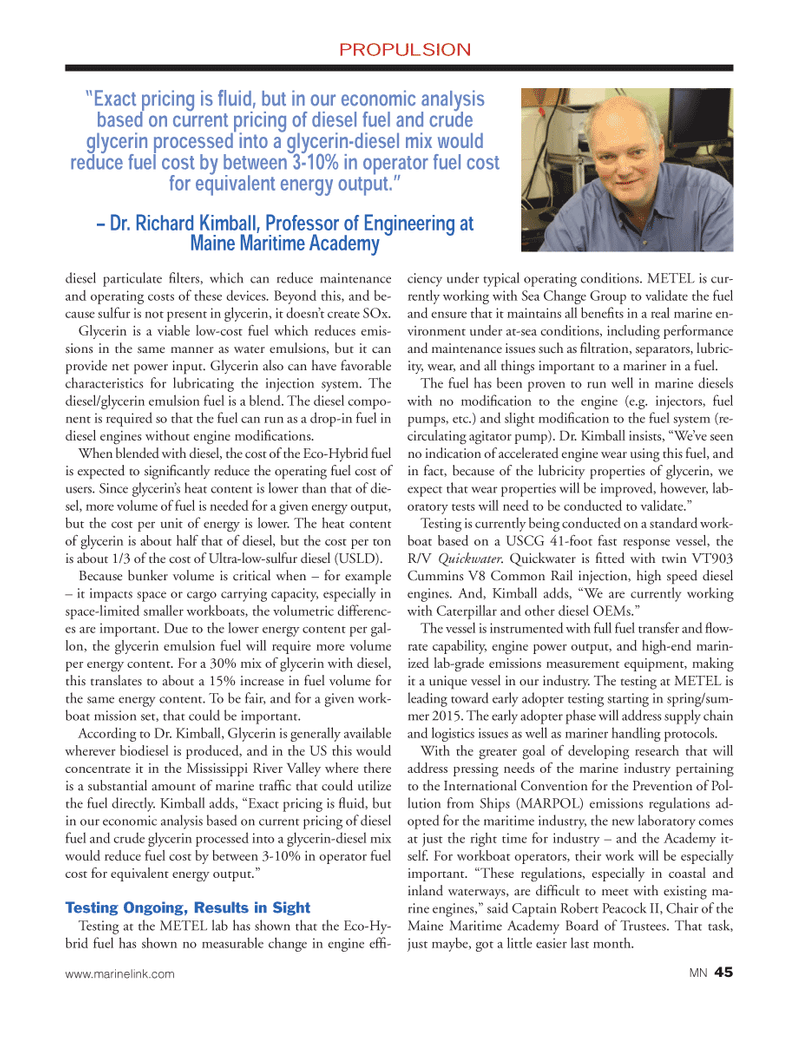
Page 45: of Marine News Magazine (December 2014)
Salvage & Spill Response
Read this page in Pdf, Flash or Html5 edition of December 2014 Marine News Magazine
diesel particulate Þ lters, which can reduce maintenance and operating costs of these devices. Beyond this, and be- cause sulfur is not present in glycerin, it doesnÕt create SOx. Glycerin is a viable low-cost fuel which reduces emis- sions in the same manner as water emulsions, but it can provide net power input. Glycerin also can have favorable characteristics for lubricating the injection system. The diesel/glycerin emulsion fuel is a blend. The diesel compo- nent is required so that the fuel can run as a drop-in fuel in diesel engines without engine modiÞ cations.When blended with diesel, the cost of the Eco-Hybrid fuel is expected to signiÞ cantly reduce the operating fuel cost of users. Since glycerinÕs heat content is lower than that of die- sel, more volume of fuel is needed for a given energy output, but the cost per unit of energy is lower. The heat content of glycerin is about half that of diesel, but the cost per ton is about 1/3 of the cost of Ultra-low-sulfur diesel (USLD). Because bunker volume is critical when Ð for example Ð it impacts space or cargo carrying capacity, especially in space-limited smaller workboats, the volumetric differenc- es are important. Due to the lower energy content per gal- lon, the glycerin emulsion fuel will require more volume per energy content. For a 30% mix of glycerin with diesel, this translates to about a 15% increase in fuel volume for the same energy content. To be fair, and for a given work- boat mission set, that could be important. According to Dr. Kimball, Glycerin is generally available wherever biodiesel is produced, and in the US this would concentrate it in the Mississippi River Valley where there is a substantial amount of marine trafÞ c that could utilize the fuel directly. Kimball adds, ÒExact pricing is ß uid, but in our economic analysis based on current pricing of diesel fuel and crude glycerin processed into a glycerin-diesel mix would reduce fuel cost by between 3-10% in operator fuel cost for equivalent energy output.Ó Testing Ongoing, Results in Sight Testing at the METEL lab has shown that the Eco-Hy- brid fuel has shown no measurable change in engine efÞ -ciency under typical operating conditions. METEL is cur-rently working with Sea Change Group to validate the fuel and ensure that it maintains all beneÞ ts in a real marine en- vironment under at-sea conditions, including performance and maintenance issues such as Þ ltration, separators, lubric- ity, wear, and all things important to a mariner in a fuel. The fuel has been proven to run well in marine diesels with no modiÞ cation to the engine (e.g. injectors, fuel pumps, etc.) and slight modiÞ cation to the fuel system (re- circulating agitator pump). Dr. Kimball insists, ÒWeÕve seen no indication of accelerated engine wear using this fuel, and in fact, because of the lubricity properties of glycerin, we expect that wear properties will be improved, however, lab- oratory tests will need to be conducted to validate.Ó Testing is currently being conducted on a standard work- boat based on a USCG 41-foot fast response vessel, the R/V Quickwater . Quickwater is Þ tted with twin VT903 Cummins V8 Common Rail injection, high speed diesel engines. And, Kimball adds, ÒWe are currently working with Caterpillar and other diesel OEMs.ÓThe vessel is instrumented with full fuel transfer and ß ow- rate capability, engine power output, and high-end marin- ized lab-grade emissions measurement equipment, making it a unique vessel in our industry. The testing at METEL is leading toward early adopter testing starting in spring/sum- mer 2015. The early adopter phase will address supply chain and logistics issues as well as mariner handling protocols. With the greater goal of developing research that will address pressing needs of the marine industry pertaining to the International Convention for the Prevention of Pol- lution from Ships (MARPOL) emissions regulations ad- opted for the maritime industry, the new laboratory comes at just the right time for industry Ð and the Academy it- self. For workboat operators, their work will be especially important. ÒThese regulations, especially in coastal and inland waterways, are difÞ cult to meet with existing ma- rine engines,Ó said Captain Robert Peacock II, Chair of the Maine Maritime Academy Board of Trustees. That task, just maybe, got a little easier last month. PROPULSION?Exact pricing is ß uid, but in our economic analysis based on current pricing of diesel fuel and crude glycerin processed into a glycerin-diesel mix would reduce fuel cost by between 3-10% in operator fuel cost for equivalent energy output.? ? Dr. Richard Kimball, Professor of Engineering at Maine Maritime Academy www.marinelink.com MN 45MN Dec14 Layout 32-49.indd 45MN Dec14 Layout 32-49.indd 4511/25/2014 11:10:07 AM11/25/2014 11:10:07 AM

 44
44

 46
46
